Budgeting Solved Assignments
VerifiedAdded on 2019/10/30
|5
|820
|342
Homework Assignment
AI Summary
This assignment provides solved examples of budgeting problems. It includes a detailed cash budget for a veterinary clinic, highlighting the clinic's negative cash balance and suggesting solutions like short-term loans. The assignment also demonstrates the creation of several budget schedules: sales budget, production budget, raw material purchases budget, and direct labor budget. It further explores how changes in budget assumptions (selling price, direct labor cost, raw material cost) affect these schedules, presenting revised budgets under two different scenarios. The solutions illustrate the process of adjusting budgets based on changing market conditions and operational factors.
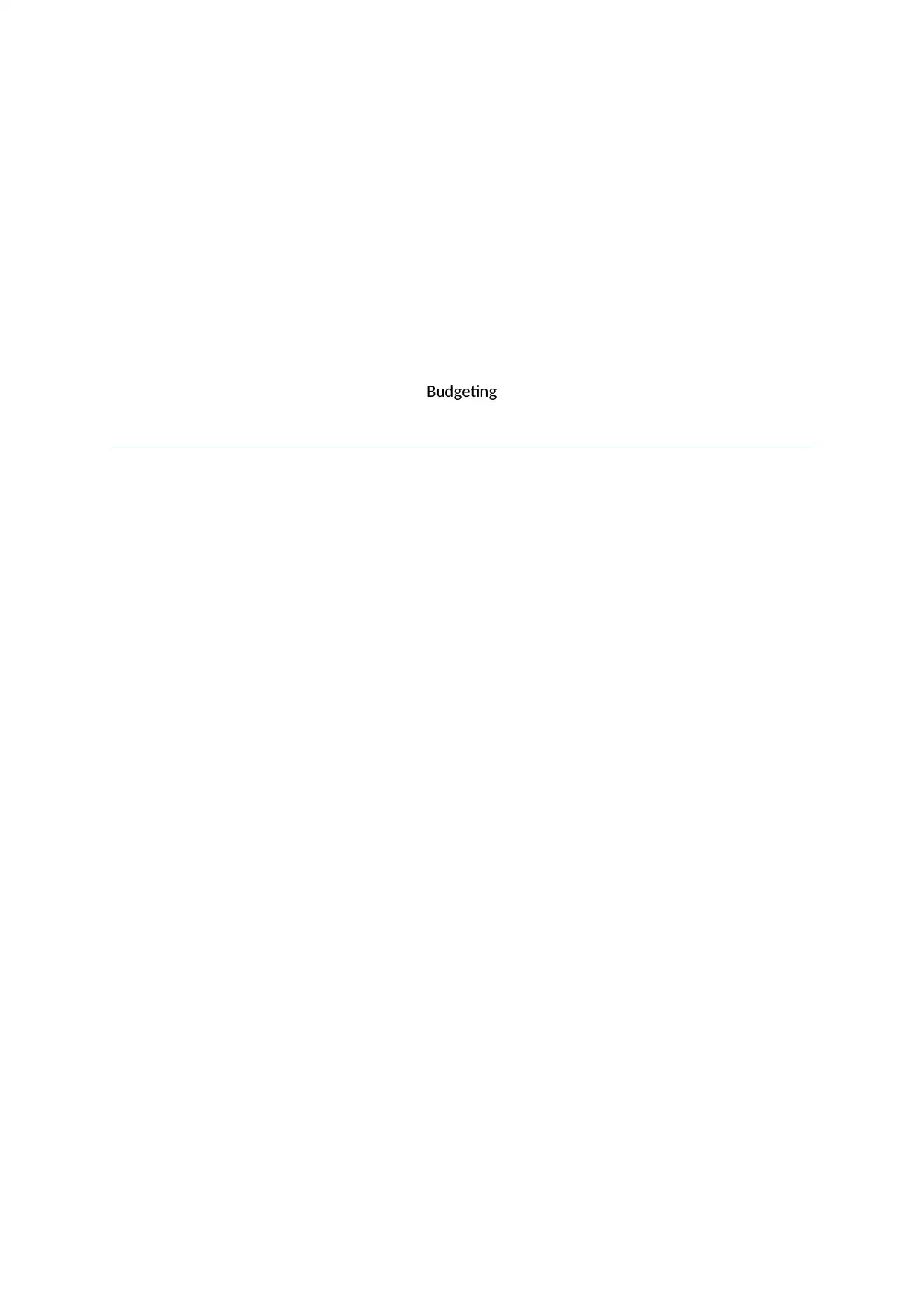
Budgeting
Paraphrase This Document
Need a fresh take? Get an instant paraphrase of this document with our AI Paraphraser
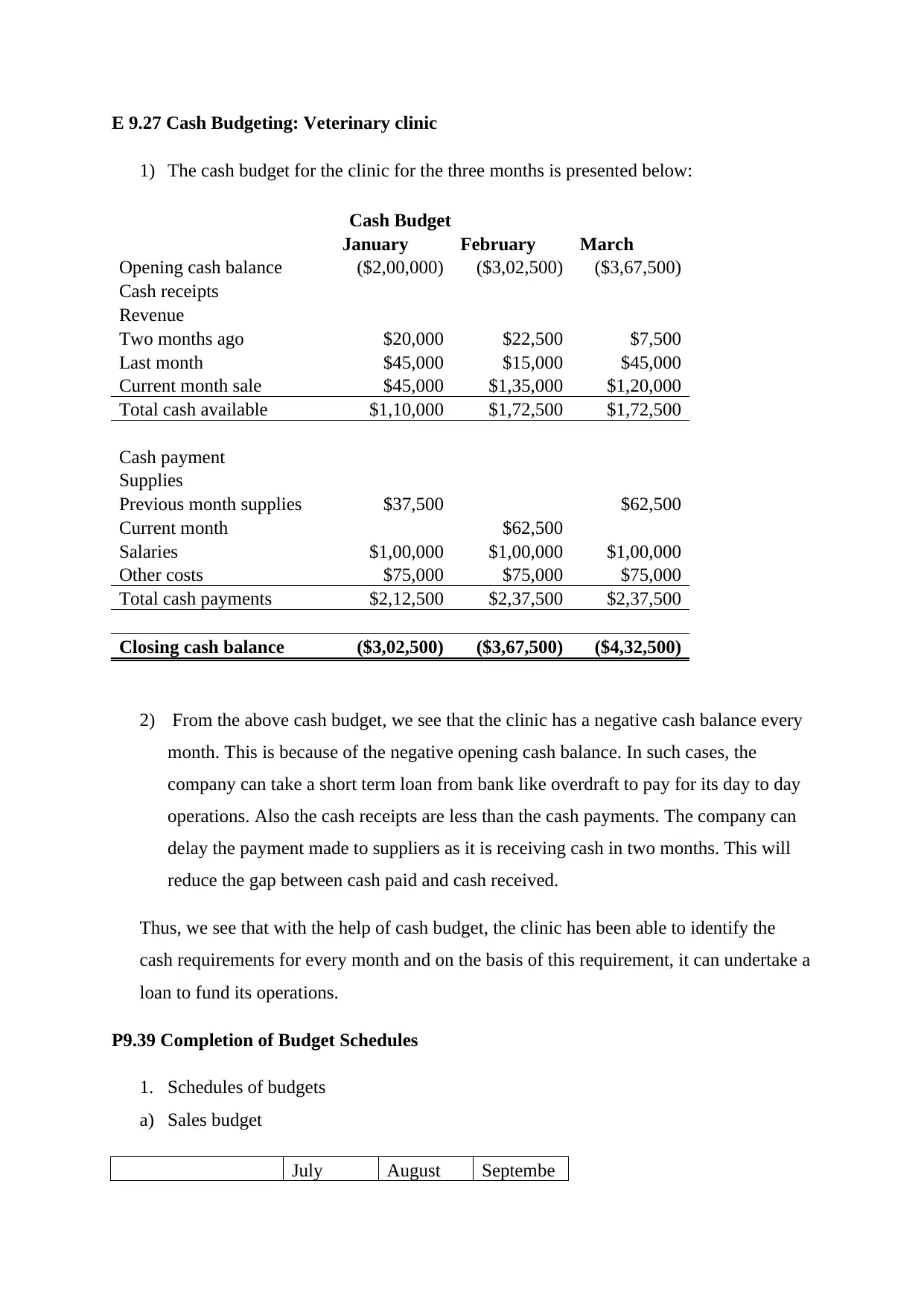
E 9.27 Cash Budgeting: Veterinary clinic
1) The cash budget for the clinic for the three months is presented below:
Cash Budget
January February March
Opening cash balance ($2,00,000) ($3,02,500) ($3,67,500)
Cash receipts
Revenue
Two months ago $20,000 $22,500 $7,500
Last month $45,000 $15,000 $45,000
Current month sale $45,000 $1,35,000 $1,20,000
Total cash available $1,10,000 $1,72,500 $1,72,500
Cash payment
Supplies
Previous month supplies $37,500 $62,500
Current month $62,500
Salaries $1,00,000 $1,00,000 $1,00,000
Other costs $75,000 $75,000 $75,000
Total cash payments $2,12,500 $2,37,500 $2,37,500
Closing cash balance ($3,02,500) ($3,67,500) ($4,32,500)
2) From the above cash budget, we see that the clinic has a negative cash balance every
month. This is because of the negative opening cash balance. In such cases, the
company can take a short term loan from bank like overdraft to pay for its day to day
operations. Also the cash receipts are less than the cash payments. The company can
delay the payment made to suppliers as it is receiving cash in two months. This will
reduce the gap between cash paid and cash received.
Thus, we see that with the help of cash budget, the clinic has been able to identify the
cash requirements for every month and on the basis of this requirement, it can undertake a
loan to fund its operations.
P9.39 Completion of Budget Schedules
1. Schedules of budgets
a) Sales budget
July August Septembe
1) The cash budget for the clinic for the three months is presented below:
Cash Budget
January February March
Opening cash balance ($2,00,000) ($3,02,500) ($3,67,500)
Cash receipts
Revenue
Two months ago $20,000 $22,500 $7,500
Last month $45,000 $15,000 $45,000
Current month sale $45,000 $1,35,000 $1,20,000
Total cash available $1,10,000 $1,72,500 $1,72,500
Cash payment
Supplies
Previous month supplies $37,500 $62,500
Current month $62,500
Salaries $1,00,000 $1,00,000 $1,00,000
Other costs $75,000 $75,000 $75,000
Total cash payments $2,12,500 $2,37,500 $2,37,500
Closing cash balance ($3,02,500) ($3,67,500) ($4,32,500)
2) From the above cash budget, we see that the clinic has a negative cash balance every
month. This is because of the negative opening cash balance. In such cases, the
company can take a short term loan from bank like overdraft to pay for its day to day
operations. Also the cash receipts are less than the cash payments. The company can
delay the payment made to suppliers as it is receiving cash in two months. This will
reduce the gap between cash paid and cash received.
Thus, we see that with the help of cash budget, the clinic has been able to identify the
cash requirements for every month and on the basis of this requirement, it can undertake a
loan to fund its operations.
P9.39 Completion of Budget Schedules
1. Schedules of budgets
a) Sales budget
July August Septembe
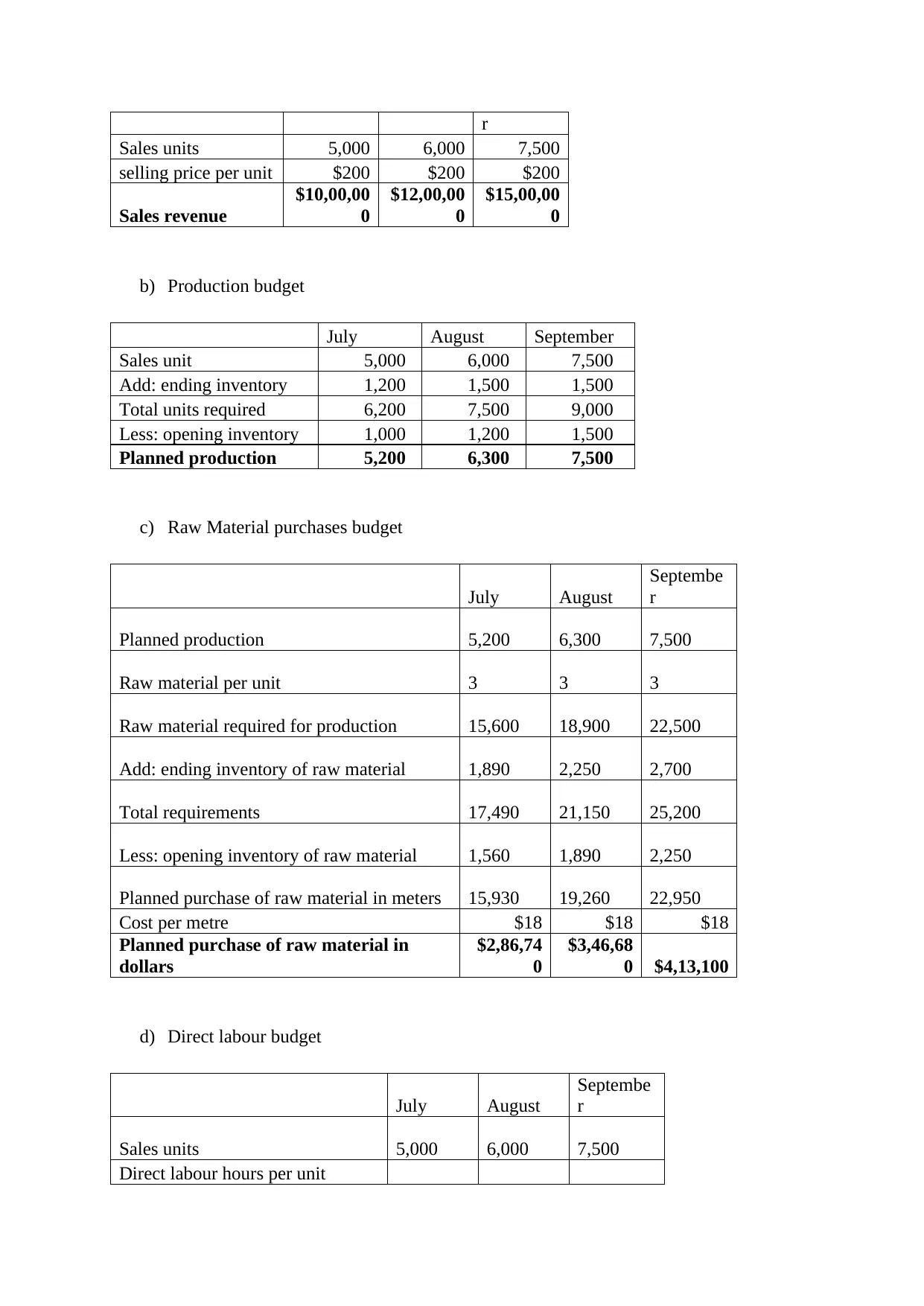
r
Sales units 5,000 6,000 7,500
selling price per unit $200 $200 $200
Sales revenue
$10,00,00
0
$12,00,00
0
$15,00,00
0
b) Production budget
July August September
Sales unit 5,000 6,000 7,500
Add: ending inventory 1,200 1,500 1,500
Total units required 6,200 7,500 9,000
Less: opening inventory 1,000 1,200 1,500
Planned production 5,200 6,300 7,500
c) Raw Material purchases budget
July August
Septembe
r
Planned production 5,200 6,300 7,500
Raw material per unit 3 3 3
Raw material required for production 15,600 18,900 22,500
Add: ending inventory of raw material 1,890 2,250 2,700
Total requirements 17,490 21,150 25,200
Less: opening inventory of raw material 1,560 1,890 2,250
Planned purchase of raw material in meters 15,930 19,260 22,950
Cost per metre $18 $18 $18
Planned purchase of raw material in
dollars
$2,86,74
0
$3,46,68
0 $4,13,100
d) Direct labour budget
July August
Septembe
r
Sales units 5,000 6,000 7,500
Direct labour hours per unit
Sales units 5,000 6,000 7,500
selling price per unit $200 $200 $200
Sales revenue
$10,00,00
0
$12,00,00
0
$15,00,00
0
b) Production budget
July August September
Sales unit 5,000 6,000 7,500
Add: ending inventory 1,200 1,500 1,500
Total units required 6,200 7,500 9,000
Less: opening inventory 1,000 1,200 1,500
Planned production 5,200 6,300 7,500
c) Raw Material purchases budget
July August
Septembe
r
Planned production 5,200 6,300 7,500
Raw material per unit 3 3 3
Raw material required for production 15,600 18,900 22,500
Add: ending inventory of raw material 1,890 2,250 2,700
Total requirements 17,490 21,150 25,200
Less: opening inventory of raw material 1,560 1,890 2,250
Planned purchase of raw material in meters 15,930 19,260 22,950
Cost per metre $18 $18 $18
Planned purchase of raw material in
dollars
$2,86,74
0
$3,46,68
0 $4,13,100
d) Direct labour budget
July August
Septembe
r
Sales units 5,000 6,000 7,500
Direct labour hours per unit
⊘ This is a preview!⊘
Do you want full access?
Subscribe today to unlock all pages.

Trusted by 1+ million students worldwide
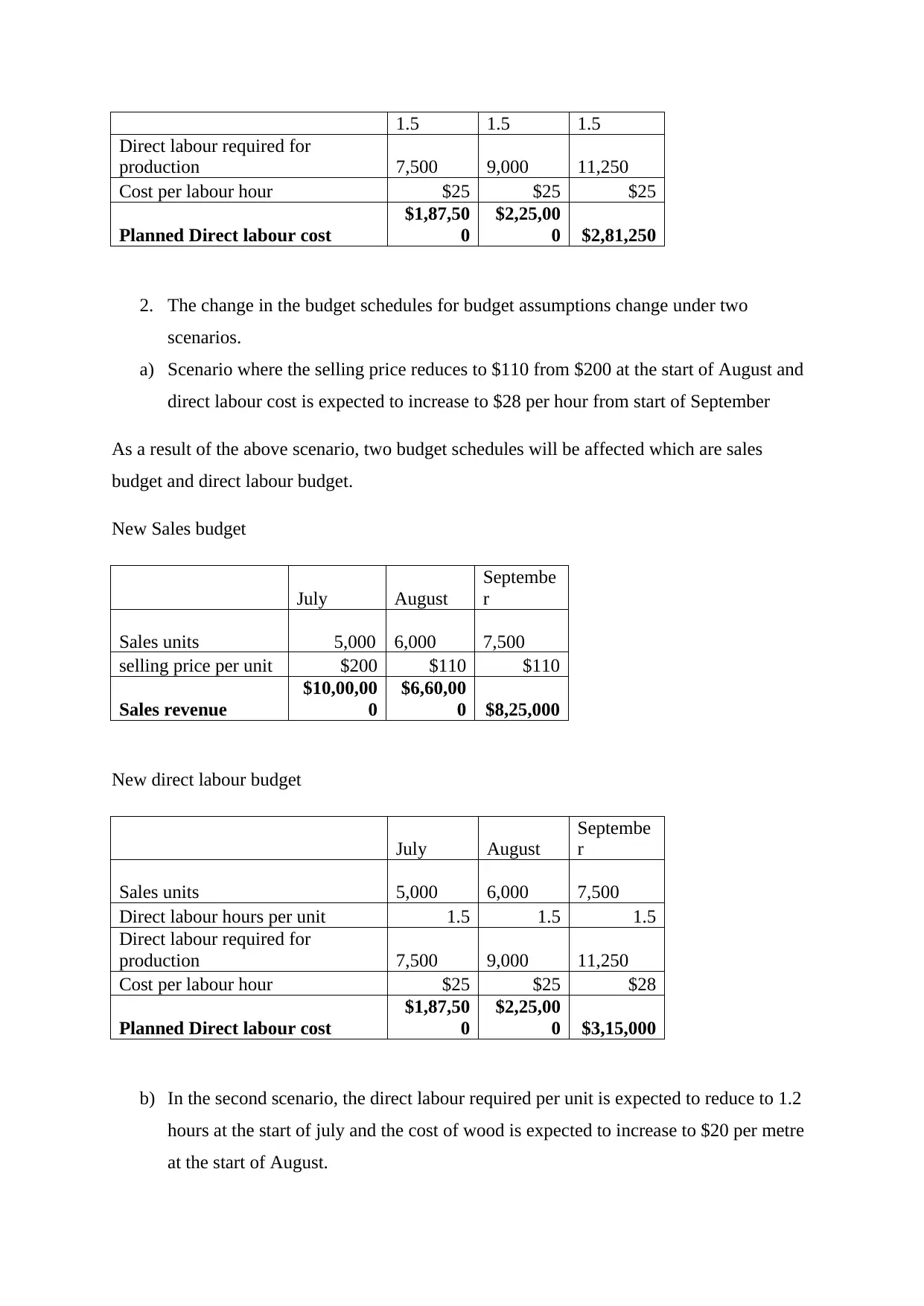
1.5 1.5 1.5
Direct labour required for
production 7,500 9,000 11,250
Cost per labour hour $25 $25 $25
Planned Direct labour cost
$1,87,50
0
$2,25,00
0 $2,81,250
2. The change in the budget schedules for budget assumptions change under two
scenarios.
a) Scenario where the selling price reduces to $110 from $200 at the start of August and
direct labour cost is expected to increase to $28 per hour from start of September
As a result of the above scenario, two budget schedules will be affected which are sales
budget and direct labour budget.
New Sales budget
July August
Septembe
r
Sales units 5,000 6,000 7,500
selling price per unit $200 $110 $110
Sales revenue
$10,00,00
0
$6,60,00
0 $8,25,000
New direct labour budget
July August
Septembe
r
Sales units 5,000 6,000 7,500
Direct labour hours per unit 1.5 1.5 1.5
Direct labour required for
production 7,500 9,000 11,250
Cost per labour hour $25 $25 $28
Planned Direct labour cost
$1,87,50
0
$2,25,00
0 $3,15,000
b) In the second scenario, the direct labour required per unit is expected to reduce to 1.2
hours at the start of july and the cost of wood is expected to increase to $20 per metre
at the start of August.
Direct labour required for
production 7,500 9,000 11,250
Cost per labour hour $25 $25 $25
Planned Direct labour cost
$1,87,50
0
$2,25,00
0 $2,81,250
2. The change in the budget schedules for budget assumptions change under two
scenarios.
a) Scenario where the selling price reduces to $110 from $200 at the start of August and
direct labour cost is expected to increase to $28 per hour from start of September
As a result of the above scenario, two budget schedules will be affected which are sales
budget and direct labour budget.
New Sales budget
July August
Septembe
r
Sales units 5,000 6,000 7,500
selling price per unit $200 $110 $110
Sales revenue
$10,00,00
0
$6,60,00
0 $8,25,000
New direct labour budget
July August
Septembe
r
Sales units 5,000 6,000 7,500
Direct labour hours per unit 1.5 1.5 1.5
Direct labour required for
production 7,500 9,000 11,250
Cost per labour hour $25 $25 $28
Planned Direct labour cost
$1,87,50
0
$2,25,00
0 $3,15,000
b) In the second scenario, the direct labour required per unit is expected to reduce to 1.2
hours at the start of july and the cost of wood is expected to increase to $20 per metre
at the start of August.
Paraphrase This Document
Need a fresh take? Get an instant paraphrase of this document with our AI Paraphraser
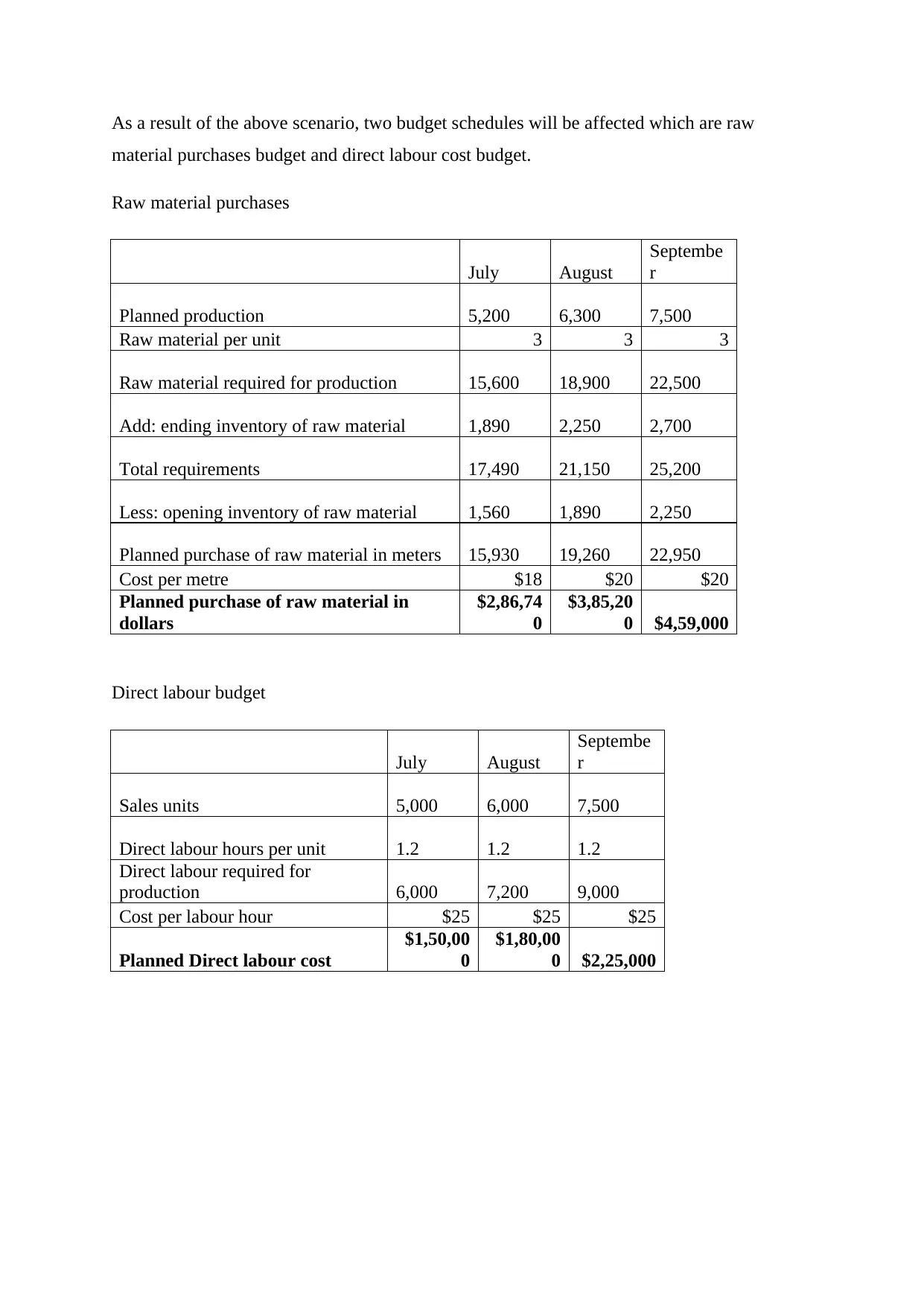
As a result of the above scenario, two budget schedules will be affected which are raw
material purchases budget and direct labour cost budget.
Raw material purchases
July August
Septembe
r
Planned production 5,200 6,300 7,500
Raw material per unit 3 3 3
Raw material required for production 15,600 18,900 22,500
Add: ending inventory of raw material 1,890 2,250 2,700
Total requirements 17,490 21,150 25,200
Less: opening inventory of raw material 1,560 1,890 2,250
Planned purchase of raw material in meters 15,930 19,260 22,950
Cost per metre $18 $20 $20
Planned purchase of raw material in
dollars
$2,86,74
0
$3,85,20
0 $4,59,000
Direct labour budget
July August
Septembe
r
Sales units 5,000 6,000 7,500
Direct labour hours per unit 1.2 1.2 1.2
Direct labour required for
production 6,000 7,200 9,000
Cost per labour hour $25 $25 $25
Planned Direct labour cost
$1,50,00
0
$1,80,00
0 $2,25,000
material purchases budget and direct labour cost budget.
Raw material purchases
July August
Septembe
r
Planned production 5,200 6,300 7,500
Raw material per unit 3 3 3
Raw material required for production 15,600 18,900 22,500
Add: ending inventory of raw material 1,890 2,250 2,700
Total requirements 17,490 21,150 25,200
Less: opening inventory of raw material 1,560 1,890 2,250
Planned purchase of raw material in meters 15,930 19,260 22,950
Cost per metre $18 $20 $20
Planned purchase of raw material in
dollars
$2,86,74
0
$3,85,20
0 $4,59,000
Direct labour budget
July August
Septembe
r
Sales units 5,000 6,000 7,500
Direct labour hours per unit 1.2 1.2 1.2
Direct labour required for
production 6,000 7,200 9,000
Cost per labour hour $25 $25 $25
Planned Direct labour cost
$1,50,00
0
$1,80,00
0 $2,25,000
1 out of 5
Related Documents
Your All-in-One AI-Powered Toolkit for Academic Success.
+13062052269
info@desklib.com
Available 24*7 on WhatsApp / Email
![[object Object]](/_next/static/media/star-bottom.7253800d.svg)
Unlock your academic potential
Copyright © 2020–2025 A2Z Services. All Rights Reserved. Developed and managed by ZUCOL.



